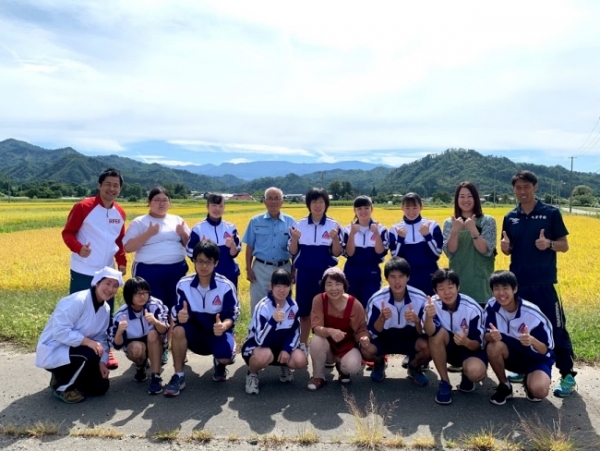Making Takahata genki through genki-na: A schoolgirl’s efforts

Dear readers, in my previous articles on Takahata Town (高畠町 Takahata-machi) in Yamagata (山形県 Yamagata-ken), I have touched on the sites of history and heritage, as well as some of the events and foods that can be enjoyed there. This time, though, let’s listen to a voice straight from Takahata itself—that of a local high-school girl currently involved in a project to revitalize the town through the organic farming it is so well-known for!
Kunori Gakuen High School (九里学園高校 Kunori Gakuen Kōkō), a high school in neighbouring Yonezawa City (米沢市 Yonezawa-shi), has been adding lessons incorporating elements of problem-solving and Sustainable Development Goals (SDGs) to their curriculum, in an effort to get students more interested and involved in local issues.
Ms Wagatsuma Riri (我妻里莉), a student from the school, took part in such a fieldwork program in Takahata as part of her lessons, and while she was drawn to the rich history of organic farming in the town, she was also struck by the various issues faced by the local community, including a lack of information on Takahata and organic farming being projected to the outside world, the lack of successors for farmers, and the overall decline of the town.

Ms Wagatsuma Riri, back when she was a high school student. (Image credit: 高畠町)
Determined to find a way to help Takahata overcome these issues, she embarked on a project to develop a product making use of genki-na (ゲンキナ), a superfood vegetable grown locally using organic methods, and came up with a Genovese sauce that incorporated the vegetable. This project of hers ended up becoming a joint effort between her school, Takahata Town, as well as Saison Factory (セゾンファクトリー), a company with their headquarters in Takahata Town that produces and sells various dressings and jams—making it a truly local venture. The following is a first-hand account by Ms Wagatsuma recounting her efforts—read on more to find out about the challenges she faced in coming up with this product, and how she managed to overcome them!
My introduction to organic farming made me want to spread its ideals and culture

The owner of Kikuchi Farm, Mr Kikuchi, showing the students around the farm. (Image credit: 高畠町)
I was moved by the softness of the earth, as well as the tastiness of organic vegetables!
It all started with a fieldwork project at Kikuchi Farm (菊地農園 Kikuchi Nōen) in Takahata Town, which was part of my lessons as a first-year high school student. Takahata, being one of the pioneers of organic farming in Japan by first adopting it in 1973, is widely considered to be a “mecca of organic farming”, and at Kikuchi Farm, we were first taught what organic farming was about by the owner, Mr Kikuchi Ryōichi (菊地良一), himself one of the forerunners of the organic movement.

(Image credit: 高畠町)
Up till that point, I had absolutely no interest in farming, and all I knew of organic farming was the vague notion that it “used less fertiliser as compared to regular farming”. However, through Mr Kikuchi’s sharing, I became aware of the importance of passing on nutrients from the earth to the crops, and these nutrients were in turn added through finely calculated and blended organic fertilisers being mixed in with the soil.
(Image credit: 高畠町)
After that, we went out into the fields to actually feel the soil for ourselves. It was completely different from what I was used to—the warmth of the earth; its soft touch when we stepped into it, almost as if it were enveloping us; its smell not unlike that of fermented foods… even now, I can still vividly recall myself thinking, “Wow, soil can be this fantastic!”, and being very touched by my realisation.

Students planting the fields as part of their fieldwork. (Image credit: 高畠町)
In addition, we also sampled dishes made by a residents’ group, Wagachanoma (我楽茶の間), featuring genki-na, yaku genmai (薬玄米)—brown rice specially grown to contain more minerals than regular brown rice, and other crops grown at Kikuchi Farm. They were all so delicious and moreish, it was too easy to go for multiple servings of the dishes—in fact, I had a few helpings of everything, which surprised the people of Wagachanoma. (laughs)
However, young people end up leaving the prefecture without realising what is good about their birthplaces.
I was born and raised in Yonezawa City, which is right next door to Takahata Town. Even though I had been in the same area all my life, I remained unaware of Takahata Town, as well as the ideals and culture of organic farming, until I took part in this fieldwork.
If young people like myself leave the prefecture in search of opportunities elsewhere without first realising what is good about their hometowns, it is possible that any future chances for them to return back someday might be lost. In addition, they might end up having the misconception that “the city has everything, but the countryside has nothing”. That might be the cause behind the population decrease, as well as the decline of towns like Takahata…
I wanted to do something for the people of Takahata. And that was how I came about the idea of creating a product with genki-na.
The journey of turning the superfood vegetable, genki-na, into a Genovese sauce

The leaves and stems of genki-na. (Image credit: 高畠町)
A superfood vegetable high in minerals and zinc!
Genki-na is a vegetable also known as oka-wakame (丘ワカメ) or Unnan hyakuyaku (雲南百薬). Compared to other leafy greens like spinach and lettuce, it is rich in minerals such as zinc, magnesium and calcium. Because it also contains a large amount of water-soluble fibre, it is also said to have a detoxing effect, as well as contributing to an increase in the body’s immune capabilities.

(Image credit: Takahata Town)
Within Takahata Town, there are a total of three farmers, including Kikuchi Farm, where genki-na is being cultivated. However, due to reasons including a lack of a market for this vegetable, close to around 1 ton of genki-na is being disposed of annually. Would it be possible to use genki-na to come up with a food product that would help spread the charms of both organic farming and Takahata Town through people consuming it? I started thinking along those lines, and eventually came up with the idea for a genki-na Genovese sauce.

The Takahata Genki-na Genovese. (Image credit: 高畠町)
In the process of developing this product, I received advice from Ms Kitabayashi Makiko (北林蒔子), Professor at the Yonezawa University of Nutrition Sciences (山形県立米沢栄養大学 Yamagata-ken-ritsu Yonezawa Eiyō Daigaku), as well as many people from Saison Factory, which has its headquarters in Takahata. After going through many sample recipes, we settled on one that included pine nuts, as well as garlic, to give it a more robust taste. With powdered cheese added, the taste of the sauce became mellower and more delicious.

(Image credit: 高畠町)
I also managed to secure the assistance of professional designers, as well as people from the Commerce and Tourism Department of Takahata Town, while coming up with the packaging for the product, and the final design was one that, though simple, managed to express the feelings of warmth and fondness I had towards Takahata.
Knowing the value of one’s hometown is the first step toward revitalization
A year after that fateful fieldwork I did as a first-year high school student, I revisited Takahata Town as I could not decide on a theme for a research project I had to do. What made me decide to embark on this current project is how the people of Takahata very warmly welcomed me, saying things like “Oh, you’re Riri-chan from that time!” and treating me as if I were family.
Takahata Town is a place where history and culture have been developed by agriculture and food coming together. Not only is it bountiful in nature, it also has a rich culture and populace. Through this genki-na Genovese, I was able to educate others, especially the younger generations, not only on the tastiness of genki-na, but also the draws of organic farming, as well as the charms of Takahata Town. That, I think, will naturally lead to the rejuvenation of Takahata.

An aerial view of fields in Yamagata. (Image credit: 山形県庁)
It might be difficult to completely resolve the problems Takahata is currently facing, like a population decline, as well as a lack of successors to take over the current generation of farmers. However, through the process of coming together to tackle these issues, links between people, as well as communities beyond schools and workplaces will definitely be created. I believe these communities are what will bring Takahata into the future.
Even after I enter university, I will continue with this project of mine, and I would like to, through this genki-na Genovese of mine, pass on the culture and ideals of organic farming the people of Takahata have shared with me to the next generation.
Tasty treats from Takahata!

An assortment of products from Takahata. (Image credit: Kevin Koh)
As mentioned in my previous articles, online retailer SUPAFRESH carries some products from Takahata, including alcoholic beverages, pickles and sauces! They are currently holding a Takahata fair (very aptly called “Terrific Takahata”), so click on the linked website to have a look at some of the products from Takahata available for purchase!
Ms Wagatsuma’s tale is a very interesting one—for one, I doubt many 16-year-olds can claim they have come up with a product that is being mass-produced and sold commercially! More importantly, though, her story of rediscovering her hometown and finding something she loved about it comes at a time when population decline has been recorded in all prefectures except Tokyo. However, there has been a U-turn of sorts ever since the COVID-19 pandemic began—perhaps, just like Ms Wagatsuma, people are now beginning to discover (or rediscover) the charms of their hometowns. Hopefully, we will hear more stories of revitalisation in the future, just like what Ms Wagatsuma did with Takahata and her genki-na Genovese!
This article is adapted and translated from a Japanese article written by Takahata Town.
Header image credit: 高畠町





